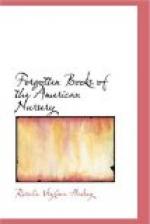To make the tales less difficult for amiable children to read, an abridgment of their contents was undertaken; and Goldsmith is said to have done much of the “cutting” in “Pamela,” “Clarissa Harlowe,” “Sir Charles Grandison,” and others. These books were included in the lists of those sent to America for juvenile reading. In Boston, Cox and Berry inserted in the “Boston Gazette and Country Journal” a notice that they had the “following little Books for all good Boys and Girls:
The Brother’s Gift, or the Naughty Girl Reformed.
The Sister’s Gift, or the Naughty Boy Reformed.
The Hobby Horse, or Christmas Companion.
The Cries of London as Exhibited in the Streets.
The Puzzling Cap.
The History of Tom Jones.
The History of Joseph Andrews. Abridg’d
from the works of H. Fielding
The History of Pamela. abridg’d from
the works of Samuel
Richardson,
Esq.
The History of Grandison.
The History of Clarissa.”
Up to this time the story has been rather of the books read by the Puritan and Quaker population of the colonies. There had arisen during the first half of the eighteenth century, however, a merchant class which owed its prosperity to its own ability. Such men sought for their families the material results of wealth which only a place like Boston could bestow. Many children, therefore, were sent to this town to acquire suitable education in books, accomplishments, and deportment. A highly interesting record of a child of well-to-do parents has been left by Anna Green Winslow, who came to Boston to stay with an aunt for the winters of 1771 and 1772. Her diary gives delightful glimpses of children’s tea-parties, fashions, and schools, all put down with a childish disregard of importance or connection. It is in these jottings of daily occurrences that proof is found that so young a girl read, quite as a matter of course, the abridged works of Fielding and Richardson.
On January 1, 1772, she wrote in her diary, “a Happy New Year, I have bestowed no new year’s gifts, as yet. But have received one very handsome one, Viz, the History of Joseph Andrews abreviated. In nice Guilt and Flowers covers.” Again, she put down an account of a day’s work, which she called “a piecemeal for in the first place I sew’d on the bosom of unkle’s shirt, and mended two pairs of gloves, mended for the wash two handkerch’fs, (one cambrick) sewed on half a border of a lawn apron of aunt’s, read part of the xxist chapter of Exodous, & a story in the Mother’s Gift.” Later she jotted in her book the loan of “3 of Cousin Charles’ books to read, viz.—The puzzling Cap, the female Orators & the history of Gaffer Two Shoes.” Little Miss Winslow, though only eleven years of age, was a typical child of the educated class in Boston, and, according to her journal, also followed the English custom of reading aloud “with Miss Winslow, the Generous Inconstant and Sir Charles Grandison.”




